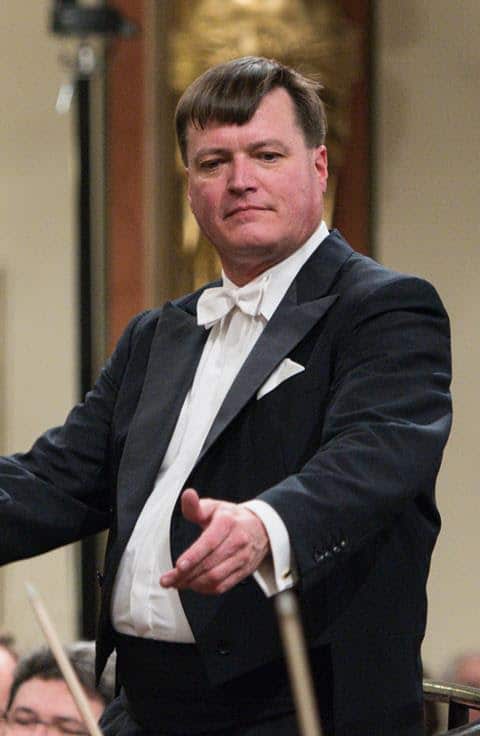Riccardo Muti: ‘A conductor who moves more than is necessary … you have to boo’
mainFrom an interview with the Chicago Maroon, a student newspaper:
Riccardo Muti: ‘In the last [several] years, we have become a visual society. So instead of listening to the music, we want to see conductors exercising on the podium, pianists that communicate with God while playing, violinists that try to impress the public with sexy attitudes…All this didn’t exist 30 years ago, 40 years ago. Today, with television and other things, people are interested in what they see. Nobody speaks about the spiritual integrity of these [artists]; what they are conveying to the public.
‘So something dramatic is happening. And instead of helping the public to become more concentrated on the substance of what art is, we are following them—giving them candies instead of vitamins. The next time you go to a concert and see a conductor who moves more than is necessary, and opens his mouth like a shark, you have to boo.’

photo (c) Todd Rosenberg
More here.





I can think of several famous conductors of the past, including one of Muti’s predecessors in Chicago, who moved a great deal, especially in their prime.
Methinks he does protest too much. As a younger man, Muti was the ultimate showman on the podium. Even the hair was choreographed!!
Yes, young Muti moved a lot. And older Muti may be wiser.
However, I wish Muti could have defined “moving too much”. Does Andris Nelsons move too much?
I unfortunately can’t remember who it was that said it, though I believe it was a conductor; his definition was that if a conductor sweat during a performance, he moved too much.
That was the second of Richard Strauss’ 10 Golden Rules for Young Conductors.
http://www.orchestergemeinschaft.de/index.php/orchester/musiker/22-taktstock.html
http://www.wqxr.org/#!/story/richard-strausss-ten-golden-rules-young-conductors/
Thank you, Petros.
I recall watching a live broadcast of Maestro Muti conducting the Beethoven 5th at the inaugural Philadelphia Orchestra concert honoring Dr. MLK’s birthday. At least at that performance both the hair and perspiration flew in all directions. Admittedly this was a special occasion but the same was true at a number of concerts I attended in the early 80’s at the Academy of Music.
There’s a difference between moving “a great deal” and moving “too much.” Certainly Solti moved a great deal, but everything he did was for the purpose of conveying his ideas clearly to the players (and singers), not for public effect. And though he may have looked awkward, at least in his Chicago period his intentions were unmistakable for the orchestra. Similarly Tennstedt — neither one was choreographed.
Shark mouth. Hmmm…..Sir Simon, perhaps?
You beat me to it!
“Opens his mouth like a shark.”
That’s a Slippedisc post, with pictures, all by itself. I’d start with the (g)nashing Rattle.
Ironically, I find that, in Chicago, when Muti moves more, the performances are more involved. He moved less last weekend during Leonara #3, and the results were a bit stoic. The second half of the program were lesser known works by Hindermith and Prokofiev. Muti appeared to throw himself into the works more, and they were excellent performances. It is less an issue of physical movement and more of the results of the performance.
I can think of a conductor who hardly moves throughout performance, and who leans back so long between movements that even experienced audiences think he is done to the point he gets belated (not spontaneous, exhilarated) applause in the wrong places.. Sorry — give me a little animation every time.
I think it’a less about how much you move and about how much your motions are extraneous to what you are trying to get the ensemble to do. If a motion of the conductor is not being done to help shape a phrase and unite the ensemble, it isn’t necessary.
So what is “more than necessary”? Even if not “exercising”, were the near-choreographed motions of Karajan or Stokowski, tight and structured as they were, any more or less a part of the performance than Bernstein’s playfulness or whole-body melancholy?
Don’t take that last sentence too literaly. He wanted to say something humorous. It shouldn’t distract you from appreciating the whole message.
Actually, I’m still kinda serious on this. Muti’s first comment about “visual society” presumes that the act of listening to music is independent of what one sees going on as it is played, and that this is a relatively new phenomenon. This I believe is inherently incorrect, but I’ll let it go for now.
The other aspect, though is the *specifics* of the phrase “All this didn’t exist 30 years ago, 40 years ago.”. 40 years ago was 1975. By that point in time, Bernstein was at his conducting peak, but more importantly, Stokowski’s reputation for his visual presence and activity had reached the point of parody multiple times over. Stokowski’s conducting was always an intentionally physical, visual act and was part of the “package” of attending his concerts. So too, Bernstein. Even the stillness of Karajan was itself an affectation, as exaggerated as any.
Conducting is a visual act as much as a musical one. They can not be separated.
More importantly, they never could.
If you don’t like a conductor’s particular style, or you think there’s a bit of a fashion for exceessive movement, fine. But express it in a way that doesn’t deny that excessive motion (or excessive, artificial stillness) didn’t exist prior to some arbitrary date.
My respect for him dropped, at least outside of music itself, over this. I hate American right-wingers for pining over a golden age of the past that never really existed. For an artist to give the same schtick earns just as little respect from me.
“Conducting is a visual act as much as a musical one. They can not be separated.”
Sorry, but that’s not thought through enough. Doesn’t make sense. Of course conducting is visual in its effect, that’s the whole point of it. To give essential cues to the musicians, without making noise that could disturb the actual music. You use your body, eyes, arms, lips, anything. Just not your voice. (in rehearsal you can use your voice)
Muti has no issue with conducting being visual. He has an issue with conductors being visual for no (musical) reason.
I appreciate Muti’s thoughts about “spiritual integrity.” In these postmodern times, artistic integrity is considered something of an antiquated concept. Under concepts such as “entrepreneurship,” market oriented pandering is the order of the day. I remember a review by Allen Kozinn of a neo-Romantic American composer in which he said a new aesthetic is evolving that could be called “Wowism” — music as saccharine, bombastic, reactionary, and pandering as it is empty. (Not that I have any less contempt for Europe’s old fashioned, Staatstheater avant-gardism, — square, rule based, and built around macho, hierarchical, nationalistic bureaucracies.)
All that said, it is absurd to think Muti isn’t a big mover and showman as the URL of photos below proves (which is so long it might not work.) He should leave dry minimalistic conducting to icy, State-Radio-bred Scandanavians like Salonen and continue his work to revive the passionate yet gracious Italian conducting style.
https://www.google.com/search?q=riccardo+muti+photos&es_sm=93&tbm=isch&imgil=o5TyuFEvD4cOhM%253A%253BY88uJB-C0XSCHM%253Bhttp%25253A%25252F%25252Fblogs.wfmt.com%25252Foffmic%25252F2015%25252F07%25252F28%25252F6-of-mutis-most-memorable-moments-in-chicago%25252F&source=iu&pf=m&fir=o5TyuFEvD4cOhM%253A%252CY88uJB-C0XSCHM%252C_&biw=1600&bih=785&usg=__2bqEmqsF1FdFkAa2-HAiSt_HLjc%3D&ved=0CDoQyjdqFQoTCOSbuuHpsMgCFcE8HgodvoINRg&ei=cU4VVqSfC8H5eL6FtrAE#imgrc=o5TyuFEvD4cOhM%3A&usg=__2bqEmqsF1FdFkAa2-HAiSt_HLjc%3D
I’m for whatever gets the desired result. Sometimes I just have to close my eyes, as I did with Giancarlo Guerrero in Denver a few seasons ago. Unfortunately for him, the result still didn’t do it for me.
I’m amused by how much verbiage people spend on this topic. Just close your eyes if you think the conductors’ movement (too much or lack thereof) will cause you anxiety. OR just stay at home and stream the music. If you’re then still driven to distraction wondering whether the conductor is moving too much, then seek help. I’m sure Norman Lebrecht’s website will soon have a list of shrinks who can help with kineto-conductophobia.
Do realize that there are those of us who sit in front of the conductor, rather than behind him or her. It makes a bit more of a difference for us….
If I may, a little walk down memory lane:
http://blogs.wfmt.com/offmic/2015/08/24/10-reaction-gifs-of-leonard-bernstein-conducting-that-you-never-knew-you-always-needed/
Probably what Muti meant is that sometimes conductors move too much with movements that have nothing to do with the music. Body movement is of course necessary while conducting and every person is different and will move differently: but there are some conductors who move to put on a show that has little to do with the music they are conducting. Having said this, I also believe that conducting completely still is equally ineffective…i think that the greatest work should be done by the conductor in the rehearsals …musical phrasing etc….in the performance the conductor should not detach him/herself from expressing thru the body or even the face his/her feelings…but i agree that jumping up and down and moving too much is also a distraction from the music and could also be useless for the players in the orchestra….
Just when I was about to accept the sad fact that everyone here seemed to have forgotten when the really important work of a conductor is done I found your comment at the end of this post. I really appreciate that you perfectly pointed it out. Thank you so much! As a fellow conductor I can only say that everybody else’s comments just prove Muti to be right in his approach, despite whether you are a fan of his or not.
His last point, or rather humorous remark, is not so much about quantity of moving, but about usefulness of movements.
Conducting is a tricky job, and the old wise men of the profession almost all tell the same tale, which took them years and decades to fully understand: To know in any given moment, when an orchestra needs you to lead, and when it doesn’t.
The public does not care about the conductor in that only musically relevant capacity.
The public wants to adore magicians, heroes and submit to powerful aristocrats.
Actually why nobody had the idea until today, to put a screen behind the conductor between him and the audience, so the audience does not get distracted by his movements and can focus better on the music? 😉
Great idea. Essentially it only happens at Bayreuth. So it’s particularly interesting to watch footage from the Bayreuth pitt, where the conductor by default does what he thinks is necessary for the musicians. Here are two supreme examples, Kna and Kleiber:
https://www.youtube.com/watch?v=NxLdDNNEc1k
https://www.youtube.com/watch?v=4nncPW69478&index=1&list=PLA799E0F0A045C121
The Boston Symphony and the Rhode Island Philharmonic have had opposite approaches to open rehearsals: the BSO has big screens showing the conductors’ movements (and there is plenty of them when Nelsons conducts). The RI Philharmonic has the conductor wear a microphone and amplifies his comments, so that the public can hear them. Which one is more interesting?
Instead of the screen, how about gagging conductors before concerts? I have never been overly bothered by a conductor’s movements, be they a stock-still Boulez, robotic Haïm, dancey Bernstein or a fervid Nelsons/Nézet-Séguin type (even if bothered, one can always close ones eyes).
What does bother me are conductors who tend to produce their own sound effects, groaning, wailing and whimpering along to the music…..Gorilla-Grunt-Rattle being one of the most frequent offenders.
Whether we like it or not, concerts are partially visual experiences for most audience members. Intelligent maestros know that very well, and the best of them, when conducting world-class orchestras, manage to move in a way that helps listeners appreciate what is happening in the music while not forgetting to give all the necessary cues – technical as well as emotional – to the instrumentalists on stage. That may mean moving slightly more than “necessary”, but it enhances listening experience for many in the audience while maintaining high quality of orchestral playing.